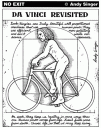Bicycle Training on a budget: How cyclists can save money!
Posted on mayo 25th, 2008 leslie dean brown
 All cyclists know that cycling can be an expensive hobby, but it doesn’t have to be. Bicycles are the most efficient form of human transport that we know of. But if you’ve started to spend ridiculous amounts of money in this sport, you might want to re-analyse the situation; if you’re flaking out loads of cash on all the latest training gizmos and whatnot, is it such an environmentally friendly sport after all? Where does your money actually end up? What do those recipients do with it? Consumers don’t tend to weigh these things up enough before purchasing something. I think I became a semi-retro-grouch when I turned 30 last year. So without further delay, here are a bunch of easy ways to help you save your hard-earned money:
All cyclists know that cycling can be an expensive hobby, but it doesn’t have to be. Bicycles are the most efficient form of human transport that we know of. But if you’ve started to spend ridiculous amounts of money in this sport, you might want to re-analyse the situation; if you’re flaking out loads of cash on all the latest training gizmos and whatnot, is it such an environmentally friendly sport after all? Where does your money actually end up? What do those recipients do with it? Consumers don’t tend to weigh these things up enough before purchasing something. I think I became a semi-retro-grouch when I turned 30 last year. So without further delay, here are a bunch of easy ways to help you save your hard-earned money:
- The easiest place to save money is with energy drinks. Simply don’t buy them; use water instead. You may argue that the latest scientific tests prove that they enhance your performance or recovery or whatnot. But the fact is, 99% of us aren’t olympic athletes. Even dressed head to toe in lycra, we don’t even pretend to be. If a cheetah can sprint up to 110km/hr without using Gatorade, I’ll be the first to admit that I don’t need it either! Some people actually argue that they are harmful to your health. While I wouldn’t go that far, they do generally make a sticky mess all over your bike’s downtube.
- My favourite energy bars are Maxim and High5. They taste great! But at 3 or 4 Australian dollars each one (£1.20 ~ ‚¬2.00), they really start to add up if you are doing heavy training. I could eat up to 4 or 5 of these on one single long ride. Worse, you really have nothing to show for it once you’ve eaten them. Go to a large supermarket and try out the muesli breakfast cereal bars that they sell. Save the expensive energy bars for when you really need a boost, not as a general fuel. Here in Tenerife, it’s easy to stop and order real food as there are over 5000 local bars! You may find that you enjoy your rides more that way too… stop & enjoy life for a change. Don’t get brainwashed into taking it all so seriously.
- If you are doing a lot of training miles on your bike, don’t be a mug and buy Dura Ace and Ultegra chains and cassettes. Good old Shimano 105 functions perfectly well and is significantly cheaper. If you use campagnolo, go with Centaur cassettes instead of Chorus or Record. In fact the steel cogs in 105 & Centaur cassettes will last considerably longer than the titanium cogs in a Dura Ace or Record cassette. Shimano Deore works just fine for MTB use. In fact these days, groups like Sora, Tiagra & Alvio work acceptably too.
- If you need things like arm warmers, buy no-name brands. While I won’t ever reccommend cheap cycling shorts for long-distance cycling, as far as headbands, arm warmers and leg warmers go, I reckon that lycra is lycra! Think of it this way: the chances are, the lycra material comes from the same factory and you’re just paying for that little logo which is ironed on afterwards.
- While convenient, CO2 cartridges definitely aren’t what you’d call cheap to replace. Use a conventional pump instead, then wait until you get home and then use a dedicated track pump to restore the high pressure in your tyres.
- Likewise, patch your punctured innertubes and re-use them instead of buying new ones all the time. Learn the correct way to repair your innertubes here.
- If you really want to be thrifty, you’ll forgo all your onboard electronic equipment despite their obvious advantages during training. Heart Rate monitors require new chest straps which can be costly; speedometers require those expensive lithium batteries (although I have a Cateye Mity 2 in a drawer that has had the same batteries at least 5 years). Other devices require expensive servicing.
- Use a light sewing-machine oil or similar instead of dedicated chain lubricants. As far as I know, Finish Line «cross country» wet lubricant is essentially mineral oil with teflon additions. Except that I can’t see any teflon particles floating about. There’s no hint of a colloidal suspension of teflon either. If there is, they’ve added it in positively minute quantities. Then you have to ask yourself the question: «is this product actually worth the price premium I’m paying for it?». So long as you regularly clean the chain, and the oil is the right consistency, it’ll be okay. Never use WD40 to lubricate a bike’s chain.
- If you haven’t bought a bike yet, or you need replacement components, don’t get caught up in the «latest & greatest». They’re generally never worth the price. A good starting price for a bicycle is ‚¬1000. At this price, you get the performance of ther higher-end bikes without the «slap in the face» pricetag. Spend more than ‚¬2000 and the value just disappears. Spend less than about ‚¬500 and the components will definitely not last as long and will require replacement anyway.
- Don’t read bike magazines! This one is simple. They’re rife with the latest equipment reviews. These alone are obviously major temptations for you to spend money. Worse, advertisements continually inundate us with stuff we really don’t need. Most ordinary souls don’t stand a chance when flooded with these types of guerrilla marketing campaigns. Ever heard of the phrase «ignorance is bliss»? If you don’t know something exists, how can you miss it? While you’re not being exposed to STUFF in general, there’s more chance for saving money.
- If you’re a man, let your hairs grow. This way, you’ll save on either the cost of razor blades, those horrible chemical treatments, or waxing (which is the best and most expensive method anyway should you like to know). And when you pass other cyclists out there on the road with their shaved and tanned legs, it’ll boost your morale enormously.





These observations make great sense.
I started as an errand-rider, then a sport rider. Now, I have returned to using my bicycle as basic transportation after about 20 years of off-and-on sport riding. I use my recent model Felt for light errands that only require a belt pack, and use my Nishiki International for heavier errands because I installed a rack and basket.
The Nishiki is 30 years old. I enjoy riding this old beater as much as I enjoy the lighter bike. I buy the cheapest components, and religiously do preventive maintenance, and am getting by just fine on very little money. In the past five months I have put fewer than 40 miles on my car, so I am saving a ton of money in that regard, too. Part of my enjoyment comes from knowing that I am doing all of this on the cheap. If anything ever happens to the Nishiki, my next beater will come from the second-hand store.
Happy riding !
Paul